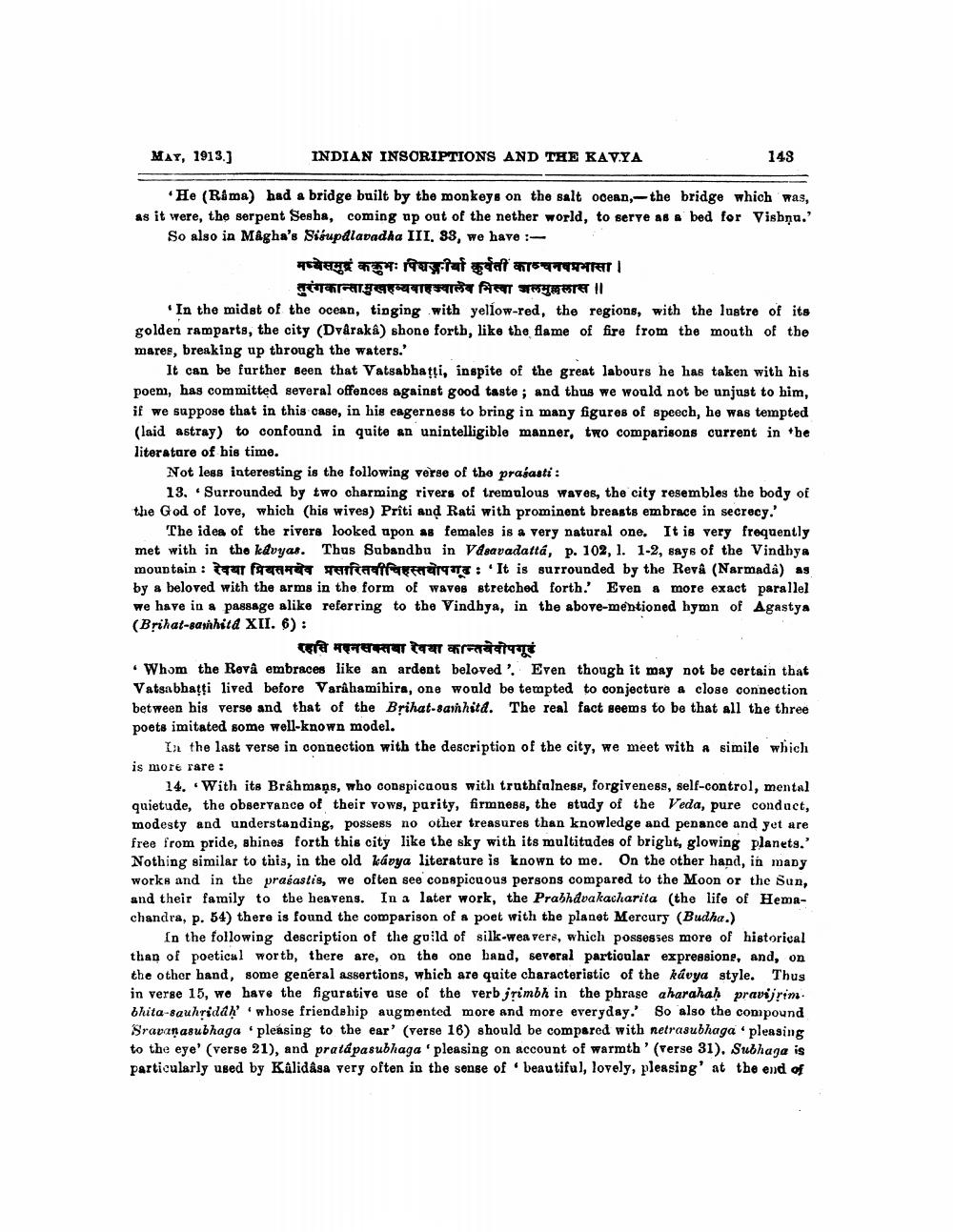________________
MAY, 1913.)
INDIAN INSORIPTIONS AND THE KAVYA
143
He (Rama) had a bridge built by the monkeys on the salt ocean, the bridge which was, as it were, the serpent Sesba, coming up out of the nether world, to serve as a bed for Visbņu.'
So also in Magha's Siśupdlavadha III. 83, we have :
तुरंगकान्सामुखहव्यवाहयालेव भित्या जलमुल्ललास ॥ In the midst of the ocean, tinging with yellow-red, the regions, with the lustre of its golden ramparts, the city (Dvaraka) shone forth, like the flame of fire from the mouth of the mares, breaking up through the waters.'
It can be further Been that Vatsabhati, inspite of the great labours he has taken with his poem, has committed several offences against good taste, and thus we would not be unjust to him, if we suppose that in this case, in his eagerness to bring in many figures of speech, he was tempted (laid astray) to confound in quite an unintelligible manner, two comparisons current in the literatare of his time.
Not less interesting is the following verse of the prasasti :
13. Surrounded by two charming rivers of tremulous waves, the city resembles the body of the God of love, which his wives) Priti and Rati with prominent breasts embrace in secrecy.
The idea of the rivers looked upon as females is a very natural one. It is very frequently met with in tho kavyas. Thus Subandbu in Vasavadattá, p. 102, 1. 1-2, says of the Vindhya mountain : tarfar Taifa
T E: 'It is surrounded by the Reva (Narmada) as by a beloved with the arms in the form of waves stretched forth. Even a more exact parallel we have in a passage alike referring to the Vindhya, in the above-mentioned hymn of Agastya (Brihat-sanhita XII. 6):
रहति मदनसक्तवा रेवया कान्तयेवोपगूढं • Whom the Rovâ embraces like an ardent beloved'. Even though it may not be certain that Vatsabhagti lived before Vardhamihira, one would be tempted to conjecture a close connection between his verse and that of the Brihat-Samhitd. The real fact seems to be that all the three poets imitated some well-known model.
In the last verse in connection with the description of the city, we meet with a simile which is more rare :
14. With its Brahmans, who conspicuous with truthfulness, forgiveness, self-control, mental quietude, the observance of their vows, parity, firmness, the study of the Veda, pure conduct, modesty and understanding, possess no other treasures than knowledge and penance and yet are free from pride, shines forth this city like the sky with its multitudes of bright, glowing planets. Nothing similar to this, in the old kávya literature is known to me. On the other hand, in many works and in the prasastis, we often see conspicuous persons compared to the Moon or the Sun, and their family to the heavens. In a later work, the Prabhdvakacharita (the life of Hemachandra, p. 54) there is found the comparison of a poet with the planet Mercury (Budha.)
In the following description of the guild of silk-wea vers, which possesses more of historical than of poetical worth, there are, on the one band, seroral particular expressione, and, on the other hand, some general assertions, which are quite characteristic of the kávya style. Thus in verse 15, we have the figurative use of the verb jimbh in the phrase aharahah pravijrin. bhita-sauhridan whose friendship augmented more and more everyday.' So also the compound Sravanasubhaga 'pleasing to the ear' (verse 16) should be compared with netrasubhaga.pleasing to the eye' (verse 21), and pratápasubhaga 'pleasing on account of warmth' (verse 31). Subhaga is particularly used by Kalidasa very often in the sense of beautiful, lovely, pleasing' at the end of




